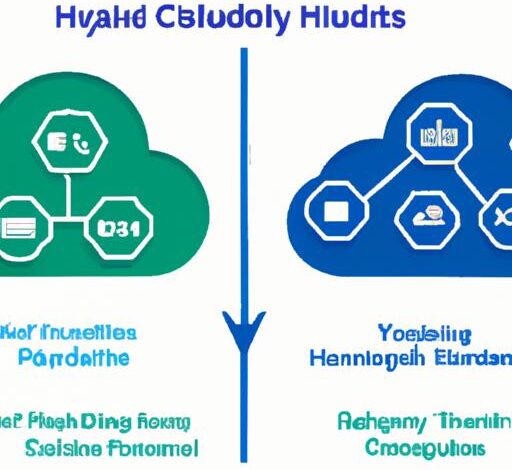Multi Cloud vs Hybrid Cloud: Choosing the Right Cloud Strategy

Introduction
As businesses increasingly rely on the cloud for their IT infrastructure, the debate between multi cloud and hybrid cloud strategies is gaining momentum. But what exactly do these terms mean, and why is it crucial to choose the right cloud strategy for your organization?
Definition of Multi Cloud and Hybrid Cloud
Multi cloud refers to the utilization of multiple cloud providers to meet specific business needs. It involves the distribution of workloads, applications, and data across different cloud platforms, such as Amazon Web Services (AWS), Microsoft Azure, and Google Cloud.
On the other hand, hybrid cloud combines public and private cloud environments, allowing organizations to leverage the benefits of both. It involves the integration of on-premises infrastructure with public cloud services, ensuring seamless data flow and workload portability.
Importance of Choosing the Right Cloud Strategy
Selecting the optimal cloud strategy is a critical decision that can impact your business’s efficiency, scalability, and overall success. By understanding the differences between multi cloud and hybrid cloud, you can make an informed choice that aligns with your specific requirements and objectives.
A well-designed cloud strategy can empower your organization to harness the full potential of cloud computing, maximize resource utilization, and drive innovation. It can also enhance data security, streamline operations, and improve cost-effectiveness.
But with the multitude of options available, how do you determine which approach is the right fit for your business? In the following sections, we will delve deeper into the features, benefits, and considerations associated with multi cloud and hybrid cloud strategies. Join me as we explore the world of cloud computing and embark on a journey to find the perfect cloud strategy tailored to your needs.
Multi Cloud: Exploring its Features and Benefits
Definition and Explanation of Multi Cloud
Multi cloud refers to the strategic use of multiple cloud providers to leverage their respective strengths and capabilities. It allows businesses to distribute workloads, applications, and data across different cloud platforms, tailoring their cloud infrastructure to specific needs and requirements. By combining the services of various cloud providers like AWS, Azure, and Google Cloud, organizations can optimize their cloud strategy.
Advantages of Multi Cloud
- Improved Flexibility and Scalability
One of the key advantages of multi cloud is its inherent flexibility. By utilizing multiple cloud providers, businesses can choose the most suitable services and features from each platform. This flexibility enables scalability, as organizations can easily scale their resources up or down based on demand. Whether it’s spinning up additional instances during peak periods or downsizing during low activity, multi cloud allows for seamless expansion and contraction of resources.
- Reduced Vendor Lock-In
Another benefit of multi cloud is the reduced risk of vendor lock-in. By diversifying their cloud infrastructure across multiple providers, businesses avoid reliance on a single vendor. This mitigates the potential impact of service disruptions, pricing changes, or other issues that may arise. Additionally, it provides the freedom to switch providers or adopt new technologies without significant disruption to operations.
- Enhanced Disaster Recovery Capabilities
Multi cloud also strengthens disaster recovery capabilities. By spreading data and applications across multiple cloud platforms, businesses ensure redundancy and minimize the risk of data loss or service interruptions. In the event of a failure or outage, organizations can quickly recover their systems by leveraging alternative cloud resources. This redundancy and resilience are critical for maintaining business continuity and minimizing downtime.
In the next section, we will delve into hybrid cloud, another popular cloud strategy that offers unique advantages and considerations.
Comparing Multi Cloud and Hybrid Cloud
A. Differentiating Factors
When considering whether to adopt a multi cloud or hybrid cloud strategy, it is essential to understand the key differentiating factors between the two approaches. Let’s explore these factors:
1. Infrastructure Composition
Multi cloud involves utilizing multiple cloud service providers, each with its own infrastructure and offerings. This allows organizations to select the best-suited provider for specific workloads or applications. In contrast, hybrid cloud combines both public and private cloud infrastructure, enabling seamless integration and workload portability between on-premises and cloud environments.
2. Data Storage and Management
In a multi cloud setup, data can be distributed across multiple cloud platforms, providing redundancy and ensuring data availability. Organizations can leverage different storage solutions based on their specific requirements. In contrast, hybrid cloud offers the flexibility to store sensitive or critical data on-premises while utilizing the scalability and cost-effectiveness of public cloud storage for non-sensitive workloads.
3. Performance and Latency
Multi cloud allows organizations to leverage the geographical presence of different cloud providers, enabling them to distribute workloads closer to end-users, reducing latency, and improving performance. Hybrid cloud, on the other hand, allows organizations to keep latency-sensitive workloads on-premises while utilizing the cloud for less critical tasks.
B. Use Cases for Multi Cloud vs Hybrid Cloud
The choice between multi cloud and hybrid cloud ultimately depends on specific use cases and business requirements. Here are some common scenarios where each strategy excels:
-
Multi cloud is ideal for organizations that require specialized services from different cloud providers, such as using AWS for its machine learning capabilities and Azure for its data analytics tools. It offers the freedom to choose the best-in-class services for each workload.
-
Hybrid cloud is well-suited for organizations with legacy systems or compliance requirements that necessitate on-premises infrastructure. It allows seamless integration between existing infrastructure and the cloud, ensuring data sovereignty and regulatory compliance.
By understanding these differentiating factors and considering your organization’s unique needs, you can make an informed decision between multi cloud and hybrid cloud, ensuring the optimal cloud strategy for your business.
Considerations for Choosing Between Multi Cloud and Hybrid Cloud
When it comes to deciding between multi cloud and hybrid cloud strategies, there are several key considerations to keep in mind. By evaluating your business requirements, workload characteristics, and budgetary constraints, you can make an informed decision that aligns with your organizational goals.
A. Business Requirements and Objectives
Understanding your business needs is paramount when selecting the right cloud strategy. Consider factors such as scalability, performance, and data sovereignty requirements. Assess whether your organization requires the flexibility to choose the best services from different cloud providers or if a combination of on-premises infrastructure and public cloud services would better suit your needs.
Additionally, consider your long-term objectives. Are you planning to expand globally? Do you anticipate substantial growth in your data volume? These considerations will help determine whether a multi cloud or hybrid cloud approach will best support your future goals.
B. Workload Characteristics
Analyzing your workload characteristics is crucial for determining the most suitable cloud strategy. Evaluate factors such as data sensitivity, computational requirements, and latency sensitivities.
For workloads that involve highly sensitive data, strict compliance regulations, or require low-latency response times, a hybrid cloud strategy may offer the necessary control and security. On the other hand, if your workloads are more dynamic, requiring rapid scalability and the ability to leverage specialized services from different cloud providers, a multi cloud approach may be more suitable.
C. Budget and Cost Analysis
Budgetary considerations play a significant role in choosing the right cloud strategy. Evaluate your organization’s financial capabilities and determine the cost implications of each approach.
While multi cloud can provide flexibility, it may also involve higher management and integration costs. Hybrid cloud, on the other hand, may require initial investments in infrastructure and maintenance. Conduct a thorough cost analysis that takes into account factors such as licensing fees, data transfer costs, and ongoing operational expenses to make an informed decision that aligns with your budget.
By carefully considering these factors, you can choose a cloud strategy that optimally supports your business requirements, workload characteristics, and financial capabilities. Remember, there is no one-size-fits-all solution, and the right choice may vary from one organization to another.
Conclusion
In conclusion, choosing between multi cloud and hybrid cloud strategies requires careful consideration of your organization’s specific needs and objectives. Both approaches offer unique features and benefits that can propel your business towards success in the digital era.
By exploring the definition and explanation of multi cloud and hybrid cloud, we have gained insights into their distinct characteristics. Multi cloud enables improved flexibility, scalability, reduced vendor lock-in, and enhanced disaster recovery capabilities. On the other hand, hybrid cloud offers optimal resource utilization, enhanced security, compliance, and cost savings opportunities.
To make an informed decision, it is essential to evaluate your business requirements, workload characteristics, and budget constraints. Assessing factors such as the composition of infrastructure, data storage and management, and performance can help determine the most suitable cloud strategy for your organization.
Remember, the right cloud strategy can empower your business to leverage the full potential of cloud computing, drive innovation, and stay ahead in today’s competitive landscape. It is a crucial investment that can streamline operations, enhance data security, and fuel growth.
As you embark on your cloud journey, take the time to weigh the pros and cons of multi cloud and hybrid cloud strategies. Seek guidance from experts, consult with industry peers, and stay updated on the latest trends and innovations. With the right cloud strategy in place, you can unlock new opportunities, drive digital transformation, and propel your organization towards a brighter future.
Choose wisely, and embrace the power of the cloud to revolutionize your business.
Conclusion: So above is the Multi Cloud vs Hybrid Cloud: Choosing the Right Cloud Strategy article. Hopefully with this article you can help you in life, always follow and read our good articles on the website: investing.dulich3mien.vn

